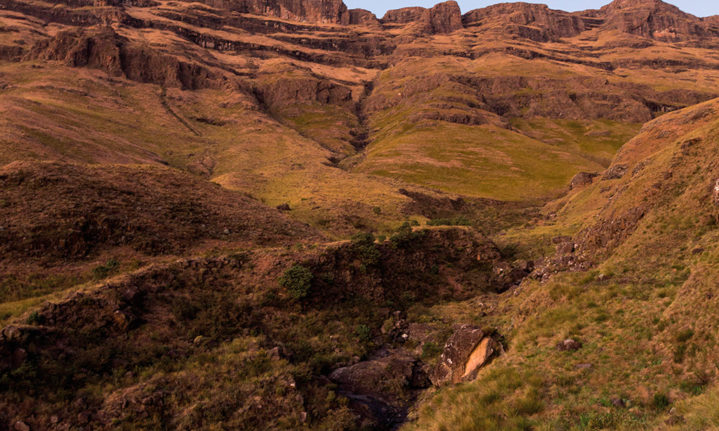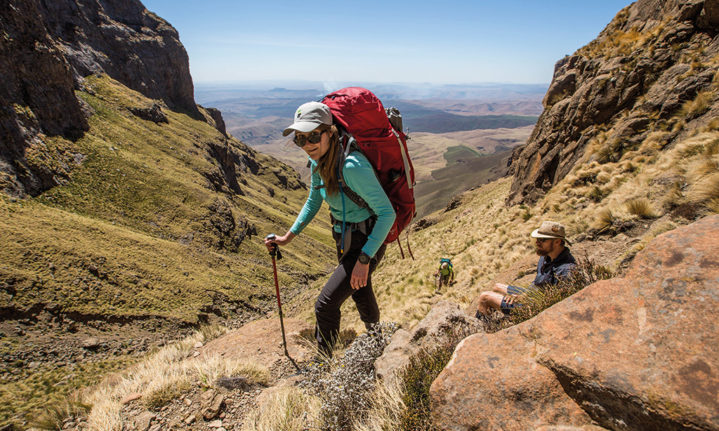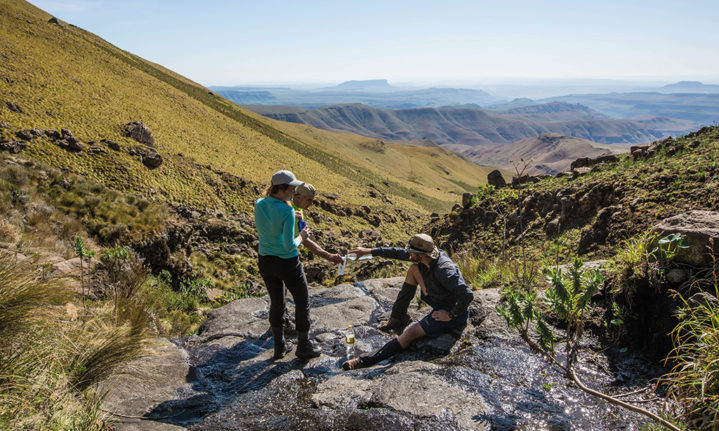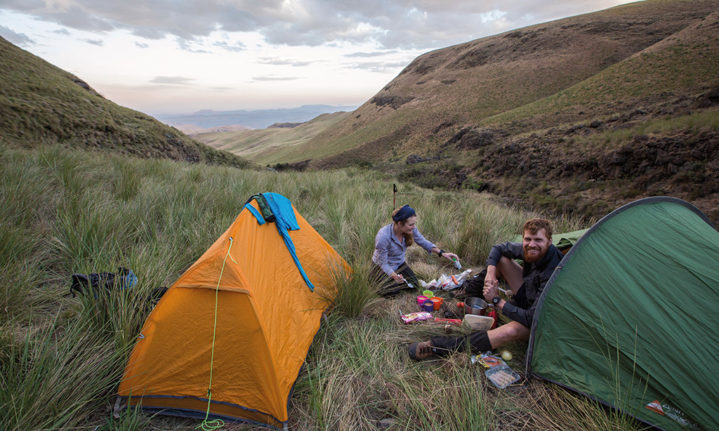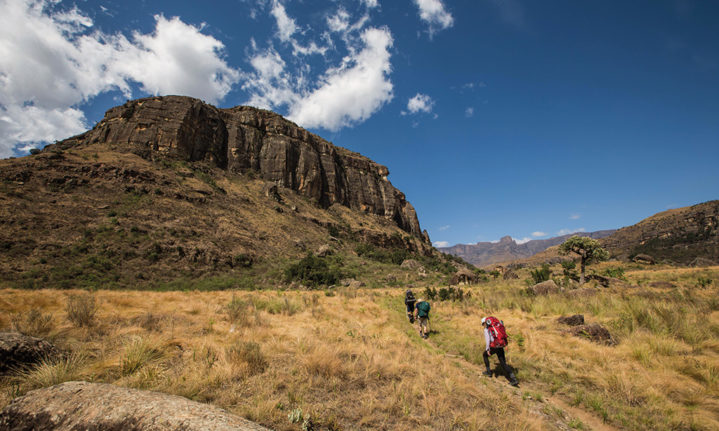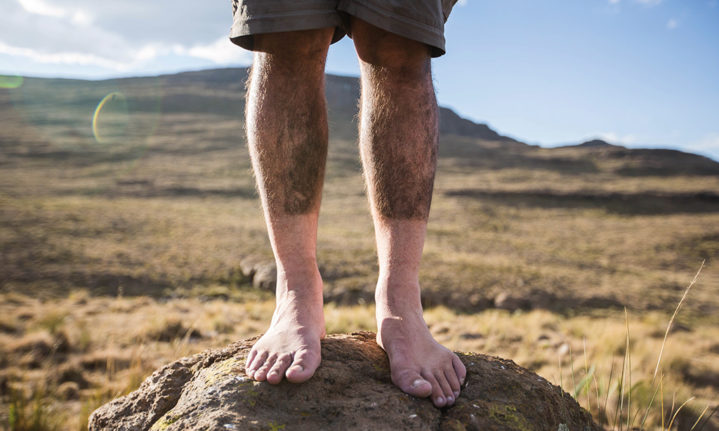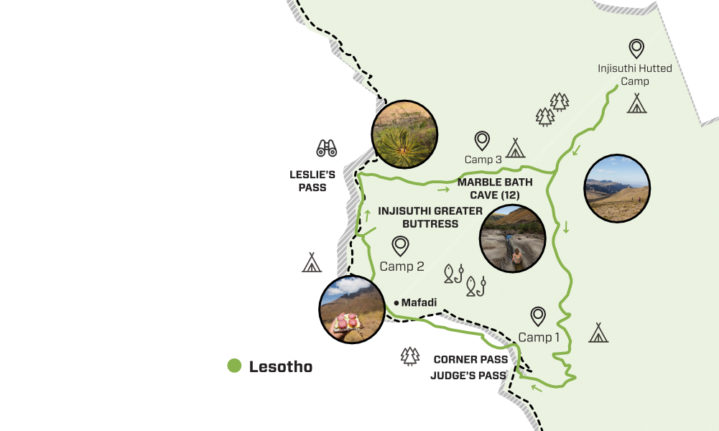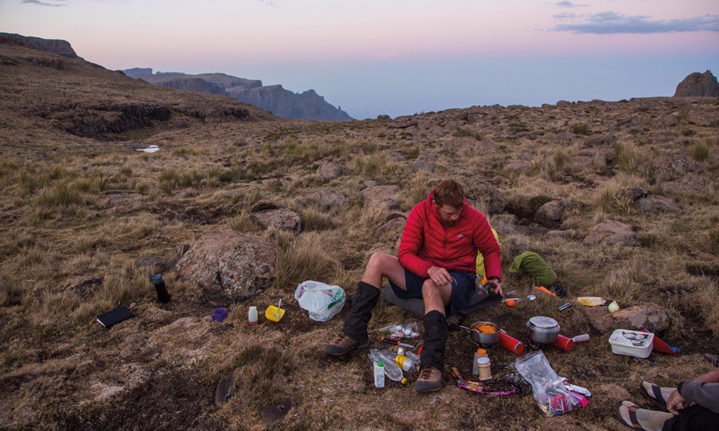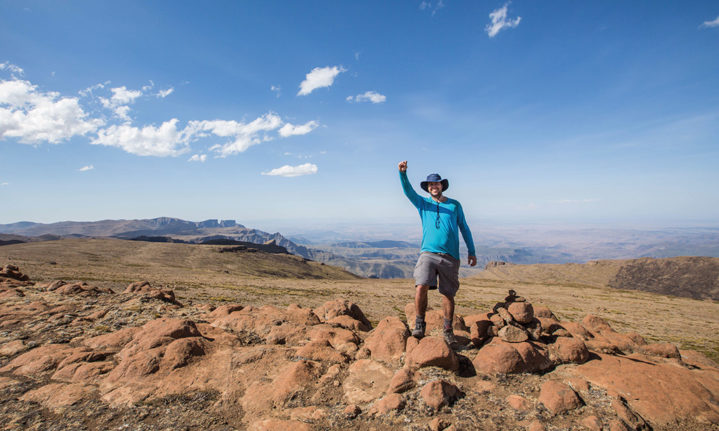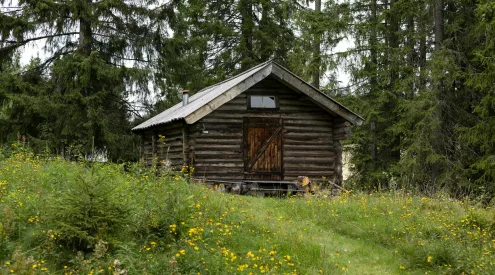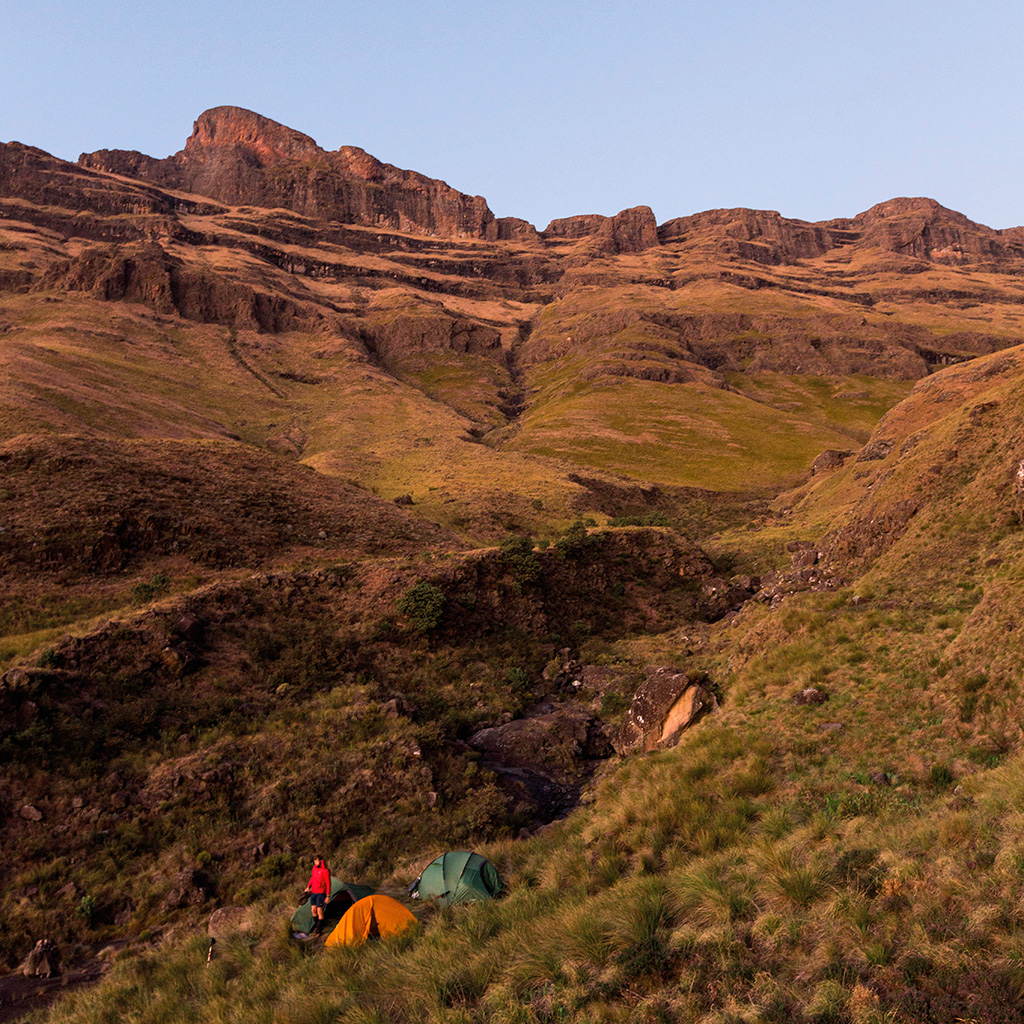
Guide Otto Wipplinger greets the morning sun from our campsite near the bottom of Judge’s Pass.
Words & Photos Matthew Sterne
Mont-aux-Sources was long considered South Africa’s highest point, but Mafadi is 300 metres taller and the real king of our castle. Matthew Sterne set out to discover the view from atop our country.
The dome-like crest of Mafadi lies several hundred metres from the edge of the Drakensberg’s escarpment, with the border between Lesotho and South Africa running right through it. The summit is a humble one – more of an insignificant flat-topped hill than a peak, 20 metres long and 100 metres wide, full of cairns built by jubilant hikers and peppered with the scars of lightning strikes from millennia of passing storms. Despite its unassuming appearance, this high-lying hill is important for one notable reason: at 3 451 metres above sea level, this is the highest point in South Africa.
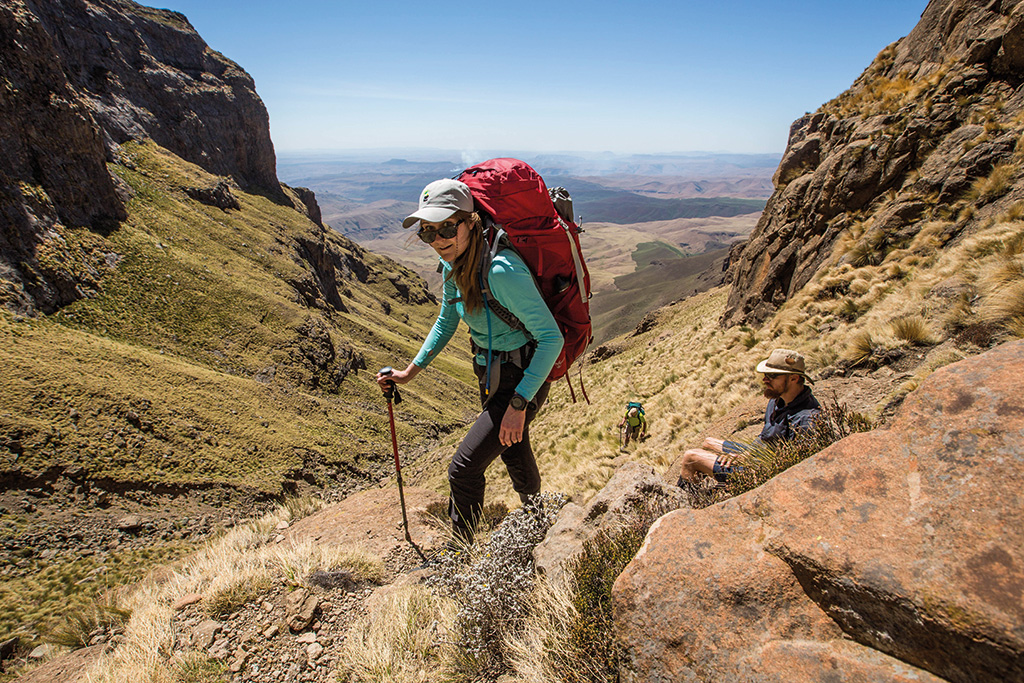
Tessa Burrows wonders how much longer the climb is going to be.
For many years, Mont-aux-Sources was thought to be South Africa’s loftiest peak. Although mountaineers from the earliest days doubted this, it was only in the 1950s that accurate measurements taken further south of the range revealed the truth. The misunderstanding, however, was perpetuated in geography books for years and, to this day, many South Africans still believe Mont-aux-Sources is our highest point.
To be honest, I was one of them. I only learned of Mafadi a few years ago through hiking friends. The more I heard, the more I wanted to climb it. It’s an ego thing, I admit, to set out to conquer the land’s highest mountain. It’s the same mentality that sees people flocking to Everest or Kilimanjaro. And while we might like to think we hike for more noble reasons than simply bagging a peak, sometimes you just want to say you did it. To know you can.
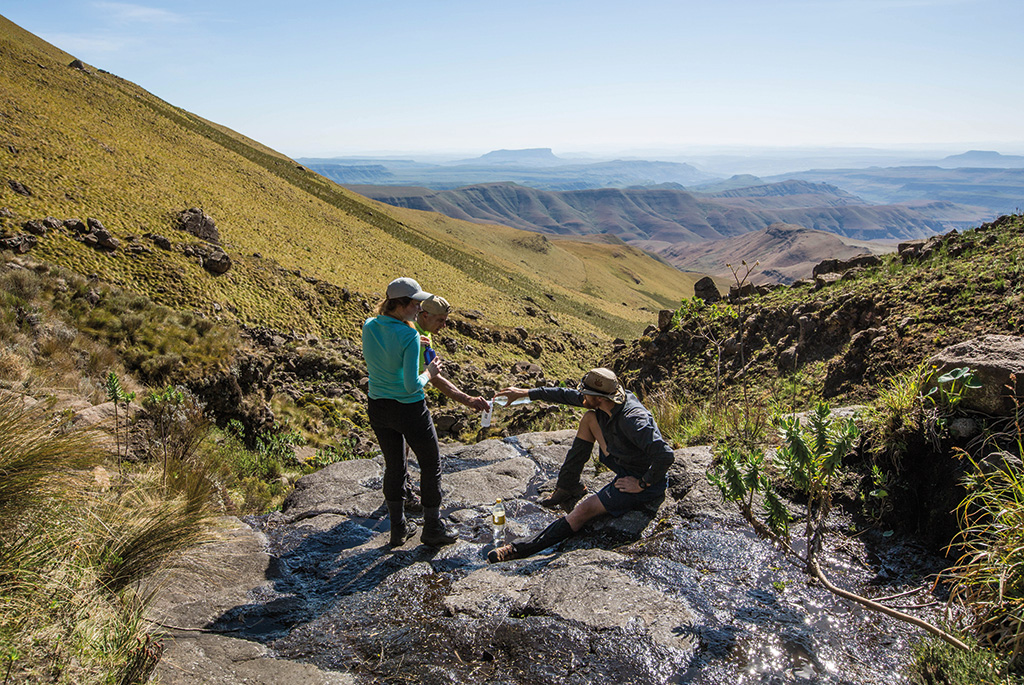
One of the great benefits of walking with a guide was knowing when to fill up our bottles and how far it was until the next water point.
A snow storm scuppered my first plans to scale Mafadi but 18 months later, during one of the Drakensberg’s worst droughts in living memory, I set off. We were a small group: guide Otto Wipplinger, the father-and-daughter duo of Tessa and Derek Burrows, and myself. We met at Injisuthi Campsite on a clear November morning and split the eight kilograms of food that Otto provided between us.
Tessa, a chef on luxury yachts, had arranged the trip as a present for her father’s 60th. I think at some point on the first afternoon, as we slogged up a steep incline, Derek may have ruefully been wishing he’d been given a pair of socks or a bottle of wine instead. That passing discomfort was richly rewarded over the next few days though, as we moved through one of the Drakensberg’s more remote hiking regions. The route of this four-day hike is simple. It’s two days of relentless ascent. Followed, more or less, by two days of descent. No technical skill is required, although sheer bloody-mindedness and an appreciation for fine views will serve you well.

We set off at the start of the hike with Injisuthi Dome looming in the distance.
Mafadi is a demanding hike, but we all agreed climbing South Africa’s highest peak shouldn’t be easy. Our group was happy to give in to the rhythm of long, quiet days of walking. We moved calmly through the barren mountain wilderness, which, due to the drought, was a toasted yellow of dry grass and parched soil as opposed to the signature green shades of Drakensberg postcards. The Italians call this meditative walking the ‘mountain person’s step’ which is slow, studiously observant and constant. They believe that, over many hours, your footsteps develop their own momentum making a hypnotic drum-like beating on the ground.
Derek, Tessa and I took it in turns to falter and fall behind. But then a change in gradient, a refreshing breeze or a short break would help us rally and push on. ‘I’ve done the Fish River Canyon Trail before,’ Derek told me. ‘But not with a pack this heavy or up hills like this.’ There was no rush, though, as it felt like we had the mountains to ourselves. We only saw one other hiking party, a few mounted Basotho herdsmen, flocks of sheep and the occasional thermal-hitching vulture. For four days, the breathtaking spires and crags, the immense mountains and valleys, the never-ending views and cold, starry nights, all belonged to us.
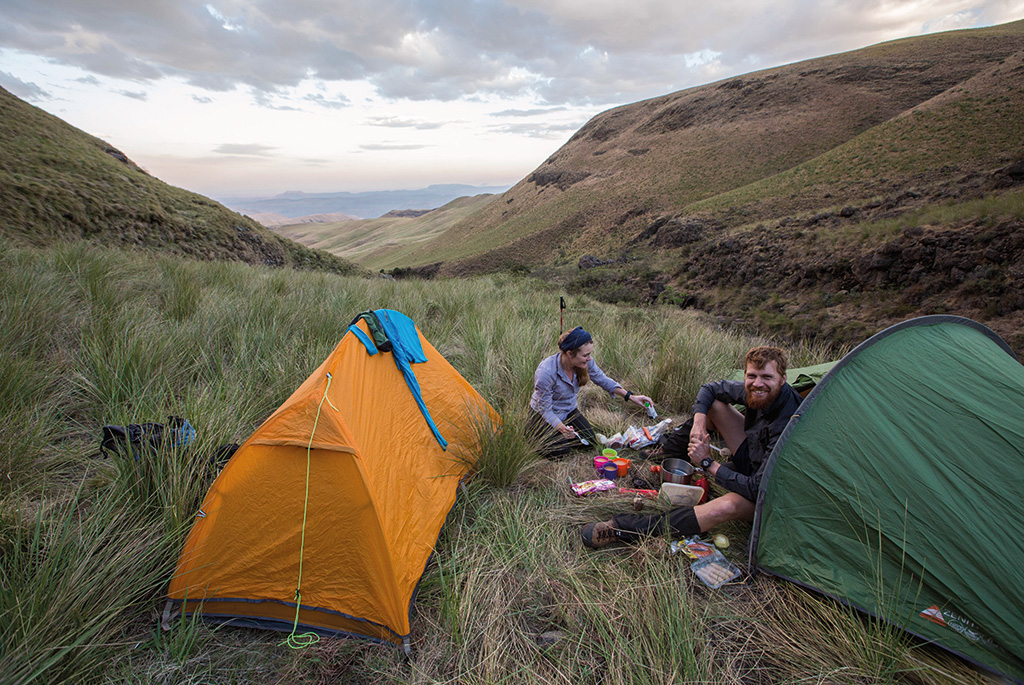
The seating might not be luxurious, but the dinner comes with a view.
Our camp settings were sublime: on a small plateau halfway up the escarpment where we were awoken by a marmalade sunrise smeared on the horizon; in a stark valley on top of the escarpment, and beside one of the Berg’s most unique rock pools. We’d bathe in the rivers near our camps as evening fell. Then we’d put on warm clothes, have a cup of rooibos with honey and help Otto prepare dinner. His Germanic heritage was evident in his nature and his precise, fuss-free movements. As we drooled over a simmering lentil soup or a chorizo pasta, Otto told us tales of search-and-rescue missions, hikes gone wrong, clients gone crazy and icy winters in the Drakensberg.
We reached the summit on the afternoon of the second day. It lay slightly off the trail, an upturned saucer waiting to be crested. Leaving our bags behind some rocks, we scampered up to a small ledge and heaved ourselves onto the top of our country. A strong gust of wind almost knocked us off our feet. We braced ourselves, triumphantly screaming into the wind and shuffled on, past the cairns and lightning-strike sites, to the highest point we could find.
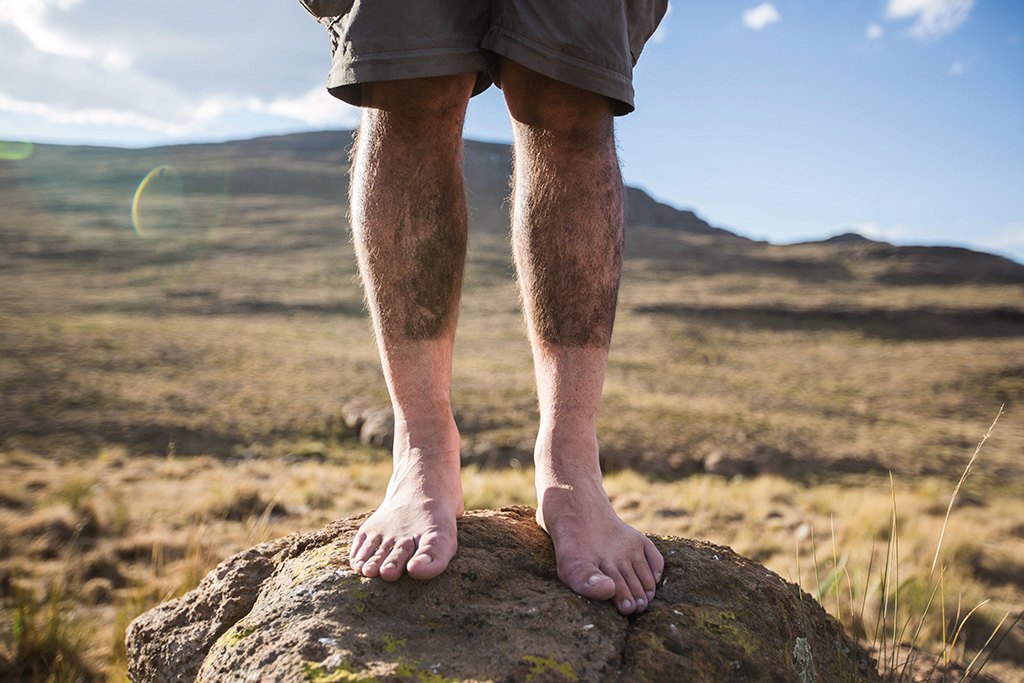
The yin and yang of dry and dusty hiking conditions.
The jagged ridges of Lesotho’s basalt mountains rolled away from us, the remnants of ancient volcanic activity, wild and unpeopled. In the distance we could make out the peak of Thabana Ntlenyana, the highest point in Africa south of Kilimanjaro, just 31 metres higher than Mafadi. While the Lesotho peak looms larger, Otto assured us our hike had more of an altitude gain as we had started from much lower.
We stood there, straddling two countries, a goal achieved, a mountain climbed. It was more than just a narcissistic conquest though. It’s up there, high above the tree line and at the furthest reaches of our capabilities, that the most poignant mountain experience lies. This is where the feel-good factor kicks in and multiplies. Sleeping on remote plateaus, greeted by a sea of clouds each morning, walking wild among these sublime mountaintops, knowing how the mountains fade away at sundown and how the wind bites on a crisp morning, unearthing a fresh perspective on your own far-removed life – this was the great joy of the climb.
And if it comes with the added benefit of bragging rights, then that’s okay too.
Route
There are a number of possible ways to reach the summit from Injisuthi Camp, but almost all use Leslie’s Pass on the descent. The route we followed was chosen because Go Trekking considers it to be the most scenic. Some hikers stay in the Upper Injisuthi Cave, near the summit. We took tents, as it gave us more flexibility to choose overnight spots.

Day 1
Injisuthi campsite to base of Judge’s Pass
13 km, 8 hours
The trail starts up the Injisuthi Valley, with occasional signposts showing the way. Take the route towards Centenary Hut. There’s rock art in an overhang near the trail so keep an eye out. The second half of the day sees you slogging straight up a hill heavily dotted with one of the 80 everlasting species in the Berg. You’ll reach Centenary Hut, a potential campsite, after about seven hours. We pushed on for another hour and slept near the bottom of Judge’s Pass next to a river, below the sheer face of the escarpment.
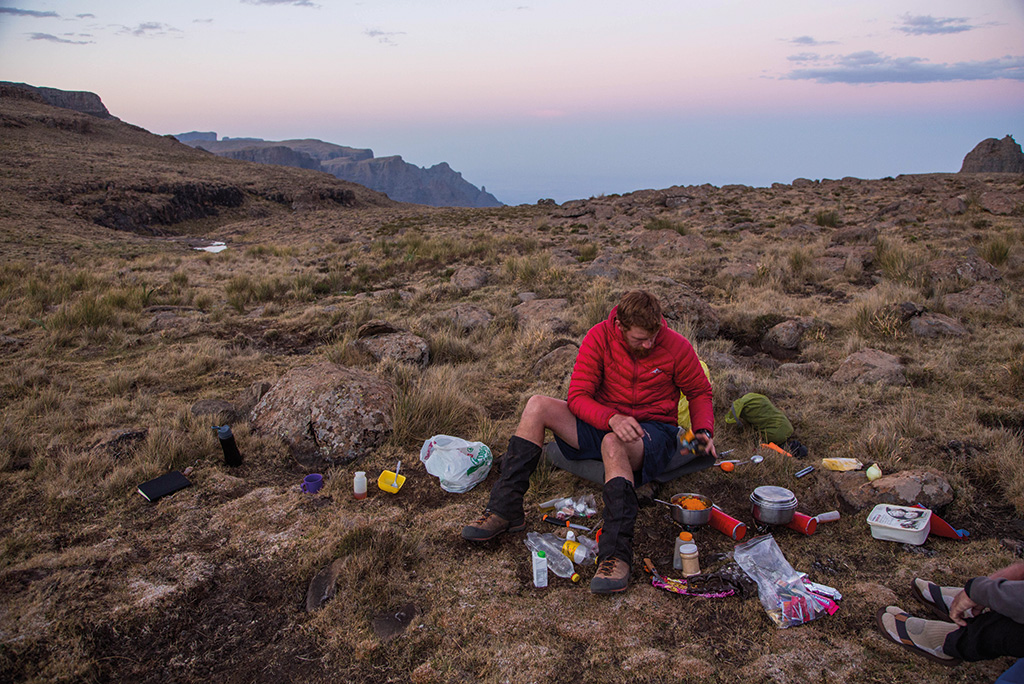
Day 2
Judge’s Pass to the plateau below Injisuthi Dome
13 km, 9,5 hours
This is the day of the big climb and it’s a long one. Follow the wonderfully flat contour path for the first hour before crossing a wide river bed of basalt boulders, Chi-Chi bushes and oldwoods. Three calf-burning hours later and you’re on the escarpment. We had lunch at the top of Corner Pass, where we could hear Cape vultures in flight as they cruised past us. Another three hours of walking takes you across a valley and then up and out of it, a gentle climb compared to the morning but still a toil. Walking at a steady pace will have you standing at the highest point in South Africa seven hours after setting off. The valley below the peak has a river to drink from and dip, with views along the escarpment towards Champagne Castle, Cathkin Peak and the Old Woman Grinding Corn.
Day 3
Injisuthi Dome to Marble Baths
9 km, 8 hours
What goes up must come down and today proves it. The top of Leslie’s Pass is a two-hour hike from the campsite. If you encounter a fierce wind on the ridgeline, as we did, you can take an alternative route behind the ridge to the top of the pass – but you won’t have the views. The beautiful Leslie’s Pass awaits with 1 200 metres and nearly three hours of descending. Towards the bottom, you’ll traverse a ridge where it feels as though you’re ‘hovering between the escarpment and the valley floor,’ as Tessa described it. Keep an eye out for endangered cycads as you make your way towards Marble Baths, a beautiful series of rock pools with a natural supertube and your camp for the night.
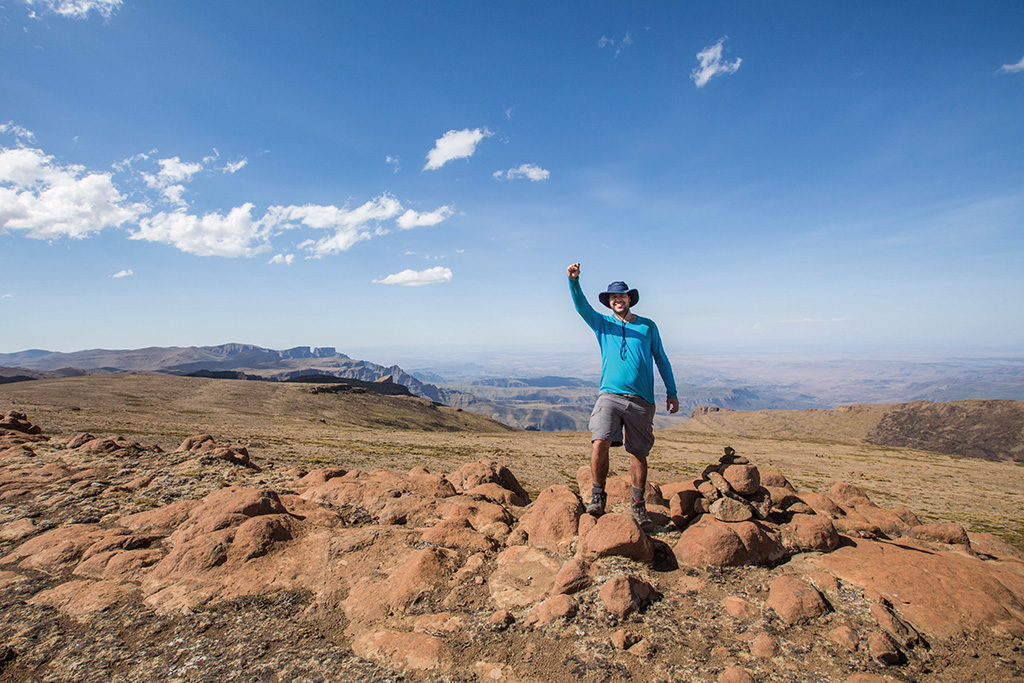
Day 4
Marble Baths to Injisuthi Campsite
9 km, 5 hours
This is a half day so there’s no need to rush out of camp. You’re now back on established trails and follow the route down the valley, past stands of yellowwoods and stinkwoods, which should get you back to Injisuthi Campsite.
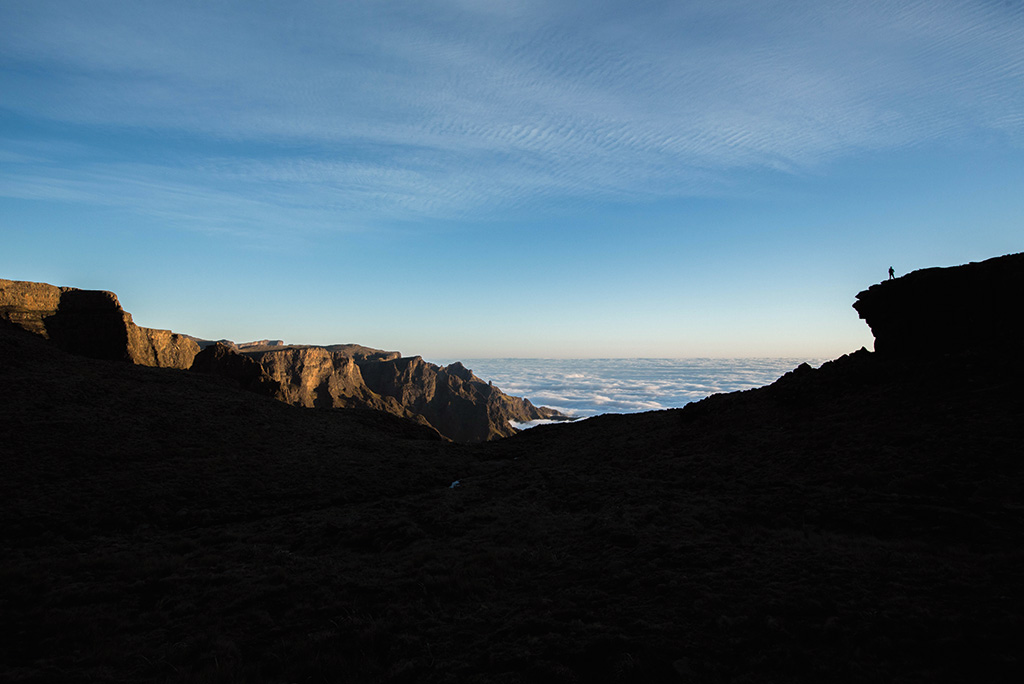
Getting There
Injisuthi camp is five hour’s drive from Johannesburg, three from Durban and one hour from Winterton on dirt road deep into the mountains.
What to pack
You’ll need a tent, sleeping bag and warm clothing for the nights – Otto says that the top of the escarpment is about 10°C colder than the valleys below. Night-time temperatures can get down to 2° in summer and -7° in winter. Go Trekking provides all the food and cooking equipment.
Cost
The four-day Mafadi peak climb is R 7 500 pp, for a minimum of two people; R 5 400 pp for three or more people. 082-731-4696, gotrekkingafrica.com









